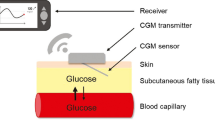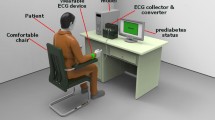Abstract
The present work presents the comparative assessment of four glucose prediction models for patients with type 1 diabetes mellitus (T1DM) using data from sensors monitoring blood glucose concentration. The four models are based on a feedforward neural network (FNN), a self-organizing map (SOM), a neuro-fuzzy network with wavelets as activation functions (WFNN), and a linear regression model (LRM), respectively. For the development and evaluation of the models, data from 10 patients with T1DM for a 6-day observation period have been used. The models’ predictive performance is evaluated considering a 30-, 60- and 120-min prediction horizon, using both mathematical and clinical criteria. Furthermore, the addition of input data from sensors monitoring physical activity is considered and its effect on the models’ predictive performance is investigated. The continuous glucose-error grid analysis indicates that the models’ predictive performance benefits mainly in the hypoglycemic range when additional information related to physical activity is fed into the models. The obtained results demonstrate the superiority of SOM over FNN, WFNN, and LRM with SOM leading to better predictive performance in terms of both mathematical and clinical evaluation criteria.



Similar content being viewed by others
References
Abiyev R, Kaynak O (2008) Fuzzy wavelet neural networks for identification and control of dynamic plants—a novel structure and comparative study. IEEE Trans Ind Electron 55(8):1–4
Baghdadi G, Nasrabadi AM (2007) Controlling blood glucose levels in diabetics by neural network predictor. In: Proceedings of the 29th annual international conference of the IEEE engineering in medicine and biology society, pp 3216–3219, Aug 22–26
Barreto G (2007) Time series prediction with the self-organizing map: a review. In: Hammer B, Hitzler p (eds) Perspectives of neural-symbolic integration, vol 77. Springer, Berlin, pp 135–158
Barreto G, Araujo A (2004) Identification and control of dynamical systems using the self-organizing map. IEEE Trans Neural Netw 15(5):1244–1259
Finan DA, et al (2006) Identification of linear dynamic models for type 1 diabetes: a simulation study. In: Proceedings of 14th IFAC ADCHEM symposium, pp 503–508, Apr 2–5
Florian JA, Parker RS (2005) Empirical modeling for glucose control in diabetes and critical care. Eur J Control 11:344–350
Georga E, et al (2009) Data mining for blood glucose prediction and knowledge discovery in diabetic patients: the METABO diabetes modeling and management system. In: Proceedings of the 31st annual international conference IEEE engineering in medicine and biology society, Minneapolis, 2009
Georga E et al (2013) Multivariate prediction of subcutaneous glucose concentration in type 1 diabetes patients based on support vector regression. IEEE Biomed Health Inform 17:71–81
Gillis R, Palerm CC, Doyle FJ (2007) Glucose estimation and prediction through meal responses using ambulatory subject data for advisory mode model predictive control. J Diabetes Sci Technol 1:825–833
Hovorka R et al (2004) Nonlinear model predictive control of glucose concentration in subjects with type 1 diabetes. Physiol Meas 25:905–920
Klonoff DC (2005) Continuous glucose monitoring: roadmap for 21st century diabetes therapy. Diabetes Care 28(5):1231–1239
Kovatchev B et al (2004) Evaluating the accuracy of continuous glucose-monitoring sensors. Diabetes Care 27(8):1922–1928
Magni L et al (2009) Model predictive control of glucose concentration in type 1 diabetic patient: an in silico trial. Biomed Signal Process Control 4:338–346
Mitsis GD, Markakis MG, Marmarelis VZ (2009) Nonlinear modeling of the dynamic effects of infused insulin on glucose: comparison of compartmental with Volterra models. IEEE Trans Biomed Eng 56:2347–2358
Mougiakakou SG et al (2008) Prediction of glucose profile in children with type 1 diabetes mellitus using continuous glucose monitors and insulin pumps. Horm Res 70:22–23
Mougiakakou SG et al (2010) SMARTDIAB: a communication and information technology approach for the intelligent monitoring, management and follow-up of type 1 diabetes patients. IEEE Trans Inf Technol Biomed 14(3):622–633
Pappada SM, Cameron BD, Rosman PM (2008) Development of a neural network for prediction of glucose concentration in type 1 diabetes patients. J Diabetes Sci Technol 2:792–801
Perez-Gandia C et al (2010) Artificial neural network algorithm for online glucose prediction from continuous glucose monitoring. Diabetes Technol Ther 12(1):81–88
Principe J, Wang L, Motter M (1998) Local dynamic modeling with self-organizing maps and applications to nonlinear system identification and control. Proc IEEE 86(11):2240–2258
Rollins D et al (2010) Free-living inferential modelling of blood glucose level using only noninvasive inputs. J Process Control 20:95–107
Sparacino G et al (2007) Glucose concentration can be predicted ahead in time from continuous glucose monitoring sensor time-series. IEEE Trans Biomed Eng 54(5):931–937
The DCCT Research Group (1993) The effect of intensive treatment of diabetes on the development and progression of long-term complications in insulin dependent diabetes mellitus. N Engl J Med 329(14):977–986
Valleta J, Chipperfield A, Byrne C (2009) Gaussian process modelling of blood glucose response to free-living physical activity data in people with type 1 diabetes. In: Proceedings of the 1st annual international conference of the IEEE engineering in medicine and biology society, pp 4913–4916, Sept 3–6
Valleta J, Chipperfield A, Byrne C (2009) Gaussian process modelling of blood glucose response to free-living physical activity data in people with type 1 diabetes. In: Proceedings of the 1st annual international conference of the ieee engineering in medicine and biology society, pp 4913–4916
Walter J, Ritter H, Schulten K (1990) Non-linear prediction with self-organizing maps. In: Proceedings of the IEEE international joint conference on neural networks (IJCNN’90), vol 1, pp 589–594, June 17–21
Wang Y, Dassau E, Doyle FJ (2010) Closed-loop control of artificial pancreatic β-cell in type 1 diabetes mellitus using model predictive iterative learning control. IEEE Trans Biomed Eng 57(2):211–219
Wilson D, Martinez T (2003) The general inefficiency of batch training for gradient descent learning. Neural Netw 16:1429–1451
Zainuddin Z, Pauline O, Ardil C (2009) A neural network approach in predicting the blood glucose level for diabetic patients. Int J Comput Intell 5(1):72–79
Zarkogianni K, et al (2013) Personalized glucose–insulin metabolism model based on self-organizing maps for patients with type 1 diabetes mellitus. In 13th IEEE international conference on bioinformatics and bioengineering (BIBE 2013), pp 1–4, Nov 10–13
Zarkogianni K, et al (2014) Neuro-fuzzy based glucose prediction model for patients with type 1 diabetes mellitus. In: IEEE-EMBS international conferences on biomedical and health informatics (BHI), June 1–4
Zarkogianni K et al (2011) An insulin infusion advisory system based on autotuning nonlinear model-predictive control. IEEE Trans Biomed Eng 58(9):2467–2477
Author information
Authors and Affiliations
Corresponding author
Rights and permissions
About this article
Cite this article
Zarkogianni, K., Mitsis, K., Litsa, E. et al. Comparative assessment of glucose prediction models for patients with type 1 diabetes mellitus applying sensors for glucose and physical activity monitoring. Med Biol Eng Comput 53, 1333–1343 (2015). https://doi.org/10.1007/s11517-015-1320-9
Received:
Accepted:
Published:
Issue Date:
DOI: https://doi.org/10.1007/s11517-015-1320-9




